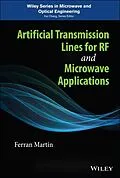This book presents and discusses alternatives to ordinary transmission lines for the design and implementation of advanced RF/microwave components in planar technology. This book is devoted to the analysis, study and applications of artificial transmission lines mostly implemented by means of a host line conveniently modified (e.g., with modulation of transverse dimensions, with etched patterns in the metallic layers, etc.) or with reactive loading, in order to achieve novel device functionalities, superior performance, and/or reduced size. The author begins with an introductory chapter dedicated to the fundamentals of planar transmission lines. Chapter 2 is focused on artificial transmission lines based on periodic structures (including non-uniform transmission lines and reactively-loaded lines), and provides a comprehensive analysis of the coupled mode theory. Chapters 3 and 4 are dedicated to artificial transmission lines inspired by metamaterials, or based on metamaterial concepts. These chapters include the main practical implementations of such lines and their circuit models, and a wide overview of their RF/microwave applications (including passive and active circuits and antennas). Chapter 5 focuses on reconfigurable devices based on tunable artificial lines, and on non-linear transmission lines. The chapter also introduces several materials and components to achieve tuning, including diode varactors, RF-MEMS, ferroelectrics, and liquid crystals. Finally, Chapter 6 covers other advanced transmission lines and wave guiding structures, such as electroinductive-/magnetoinductive-wave lines, common-mode suppressed balanced lines, lattice-network artificial lines, and substrate integrated waveguides. Artificial Transmission Lines for RF and Microwave Applications provides an in-depth analysis and discussion of artificial transmission lines, including design guidelines that can be useful to researchers, engineers and students.
Autorentext
FERRAN MARTÍN is Full Professor of Electronics in the Departament d'Enginyeria Electrònica at the Universitat Autònoma de Barcelona (UAB) in Spain. He is the Head of the Microwave Engineering, Metamaterials and Antennas Group (GEMMA) at UAB and the Director of CIMITEC, a research center on metamaterials. Dr. Martín has generated over 450 book chapters, journal papers, and conference contributions (most of them on topics related to the book) and has supervised 14 PhDs. He holds one of the Parc de Recerca UAB/ Santander Technology Transfer Chairs at UAB and has been the recipient of the Duran Farell Prize (2006) and the ICREA Academia Award (2008 and 2013). He is IEEE Fellow since 2012.
Inhalt
Preface xiii
Acknowledgments xvii
1 Fundamentals of Planar Transmission Lines 1
1.1 Planar Transmission Lines Distributed Circuits and Artificial Transmission Lines 1
1.2 Distributed Circuit Analysis and Main Transmission Line Parameters 5
1.3 Loaded (Terminated) Transmission Lines 8
1.4 Lossy Transmission Lines 16
1.4.1 Dielectric Losses: The Loss Tangent 19
1.4.2 Conductor Losses: The Skin Depth 25
1.5 Comparative Analysis of Planar Transmission Lines 28
1.6 Some Illustrative Applications of Planar Transmission Lines 31
1.6.1 Semilumped Transmission Lines and Stubs and Their Application to Low-Pass and Notch Filters 31
1.6.2 Low-Pass Filters Based on Richard's Transformations 39
1.6.3 Power Splitters Based on /4 Lines 40
1.6.4 Capacitively Coupled /2 Resonator Bandpass Filters 42
References 44
2 Artificial Transmission Lines based on Periodic Structures 47
2.1 Introduction and Scope 47
2.2 Floquet Analysis of Periodic Structures 48
2.3 The Transfer Matrix Method 53
2.3.1 Dispersion Relation 54
2.3.2 Bloch Impedance 56
2.3.3 Effects of Asymmetry in the Unit Cell through an Illustrative Example 60
2.3.4 Comparison between Periodic Transmission Lines and Conventional Lines 62
2.3.5 The Concept of Iterative Impedance 63
2.4 Coupled Mode Theory 64
2.4.1 The Cross-Section Method and the Coupled Mode Equations 65
2.4.2 Relation between the Complex Mode Amplitudes and S-Parameters 69
2.4.3 Approximate Analytical Solutions of the Coupled Mode Equations 71
2.4.4 Analytical Expressions for Relevant Parameters of EBG Periodic Structures 77
2.4.5 Relation between the Coupling Coefficient and the S-Parameters 79
2.4.6 Using the Approximate Solutions of the Coupled Mode Equations 80
2.5 Applications 86
2.5.1 Applications of Periodic Nonuniform Transmission Lines 86
2.5.1.1 Reflectors 86
2.5.1.2 High-Q Resonators 92
2.5.1.3 Spurious Suppression in Planar Filters 93
2.5.1.4 Harmonic Suppression in Active Circuits 95
2.5.1.5 Chirped Delay Lines 99
2.5.2 Applications of Reactively Loaded Lines: The Slow Wave Effect 102
2.5.2.1 Compact CPW Bandpass Filters with Spurious Suppression 105
2.5.2.2 Compact Microstrip Wideband Bandpass Filters with Ultrawideband Spurious Suppression 108
References 114
3 Metamaterial Transmission Lines: Fundamentals Theory Circuit Models and Main Implementations 119
3.1 Introduction Terminology and Scope 119
3.2 Effective Medium Metamaterials 122
3.2.1 Wave Propagation in LH Media 123
3.2.2 Losses and Dispersion in LH Media 125
3.2.3 Main Electromagnetic Properties of LH Metamaterials 127
3.2.3.1 Negative Refraction 128
3.2.3.2 Backward Cerenkov Radiation 129
3.2.4 Synthesis of LH Metamaterials 131
3.2.4.1 Negative Effective Permittivity Media: Wire Media 132
3.2.4.2 Negative Effective Permeability Media: SRRs 136
3.2.4.3 Combining SRRs and Metallic Wires: One-Dimensional LH Medium 139
3.3 Electrically Small Resonators for Metamaterials and Microwave Circuit Design 141
3.3.1 Metallic Resonators 142
3.3.1.1 The Non-Bianisotropic SRR (NB-SRR) 142
3.3.1.2 The Broadside-Coupled SRR (BC-SRR) 142
3.3.1.3 The Double-Slit SRR (DS-SRR) 143
3.3.1.4 The Spiral Resonator (SR) 144
3.3.1.5 The Folded SIR 144
3.3.1.6 The Electric LC Resonator (ELC) 145
3.3.1.7 The Open Split-Ring Resonator (OSRR) 146
3.3.2 Applying Duality: Complementary Resonators 146
3.3.2.1 Complementary Split-Ring Resonator (CSRR) 147
3.3.2.2 Open Complementary Split-Ring Resonator (OCSRR) 149
3.4 Canonical Models of Metamaterial Transmission Lines 149
3.4.1 The Dual Transmission Line Concept 150
3.4.2 The CRLH Transmission Line 154
